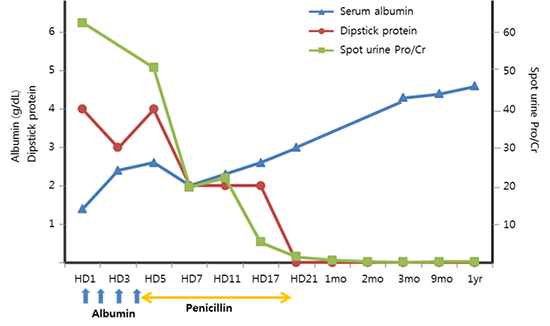1. Phiske MM. Current trends in congenital syphilis. Indian J Sex Transm Dis. 2014; 35:12–20.
2. Peterman TA, Su J, Bernstein KT, Weinstock H. Syphilis in the United States: on the rise? Expert Rev Anti Infect Ther. 2015; 13:161–168.
4. Korea Centers for Disease Control and Prevention. Infectious diseases surveillance [Internet]. accessed on 10 October 2015. Available at
http://is.cdc.go.kr/dstat/index.jsp.
5. Patterson MJ, Davies HD. Syphilis (Treponema pallidum). In : Kliegman RM, Stanton BF, St. Geme JW, Schor NF, Behrman RE, editors. Nelson Textbook of Pediatrics. 19th ed. Philadelphia, PA: Elsevier Saunders;2011. p. 1016–1022.
6. Braunstein GD, Lewis EJ, Galvanek EG, Hamilton A, Bell WR. The nephrotic syndrome associated with secondary syphilis. An immune deposit disease. Am J Med. 1970; 48:643–648.
7. Woods CR. Syphilis in children: congenital and acquired. Semin Pediatr Infect Dis. 2005; 16:245–257.
8. Kang SH, Lee JH, Choi SH, Lee J, Yoon HS, Cha SH, Choi YS. Recent change in congenital syphilis in Korea: retrospective 10 year study. Pediatr Int. 2015; 57:1112–1115.
9. Thompson L. Syphilis of the kidney. JAMA. 1920; 75:17–20.
10. Platou RV, Hill AJ Jr, Ingraham NR, Goodwin MS, Wilkinson EE, Hansen AE. Effect of penicillin in the treatment of infantile congenital syphilis; further observations. Am J Dis Child. 1946; 72:635–648.
11. Reynoso García M, Vargas Rosendo R. Congenital syphilis with nephrotic syndrome. Bol Med Hosp Infant Mex. 1979; 36:425–432.
12. Wiggelinkhuizen J, Kaschula RO, Uys CJ, Kuijten RH, Dale J. Congenital syphilis and glomerulonephritis with evidence for immune pathogenesis. Arch Dis Child. 1973; 48:375–381.
13. Suskind R, Winkelstein JA, Spear GA. Nephrotic syndrome in congenital syphilis. Arch Dis Child. 1973; 48:237–239.
14. Scully JP, Yamazki JN. Congenital syphilitic nephrosis successfully treated with penicillin. Am J Dis Child. 1949; 77:652–658.
15. Shim SH, Kim JY, Lee EK, Bang K, Cho KS, Lee J, Suh JS, Bin JH, Kim HH, Lee WB. Congenital syphilis: an uncommon cause of gross hematuria, skin rash, and pneumonia. Korean J Pediatr Infect Dis. 2014; 21:65–70.
16. Park HO, Lim JW, Jin HS, Shim JW, Kim MH, Kim CS, Kim ER, Kim SY, Park SK, Lee JJ. Comparative study of newborns of Asian immigrant and Korean women. Korean J Pediatr. 2009; 52:1119–1126.
17. Simms I, Ward H. Congenital syphilis in the United Kingdom. Sex Transm Infect. 2006; 82:1.
18. Tucker JD, Chen XS, Peeling RW. Syphilis and social upheaval in China. N Engl J Med. 2010; 362:1658–1661.
19. Leeyaphan C, Jiamton S, Prasertworonun N, Maneeprasopchoke P, Omcharoen V. Clinical and epidemiological characteristics of patients with syphilis: 5 year-case study from Thailand. J Med Assoc Thai. 2014; 97:963–968.
20. Centers for Disease Control and Prevention (US). Sexually transmitted disease surveillance 2014 [Internet]. accessed on 27 March 2016. Available at
http://www.cdc.gov/std/stats14/.





